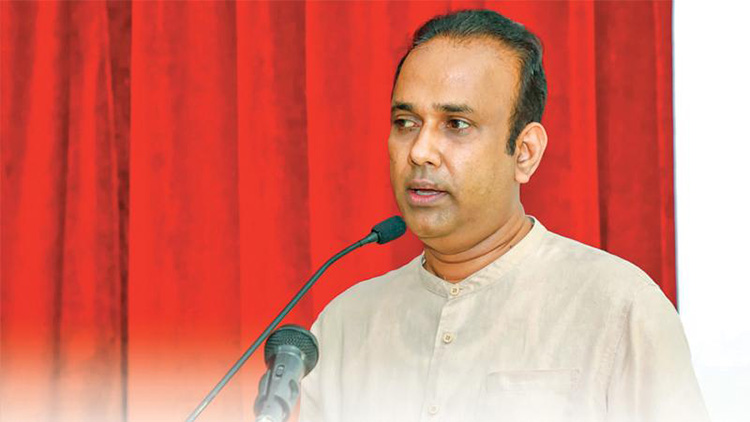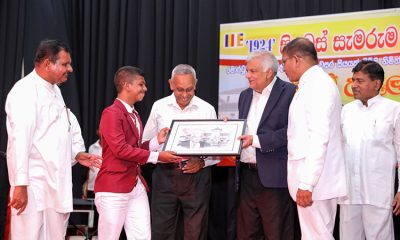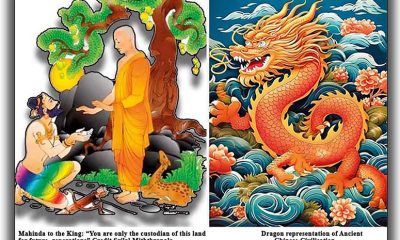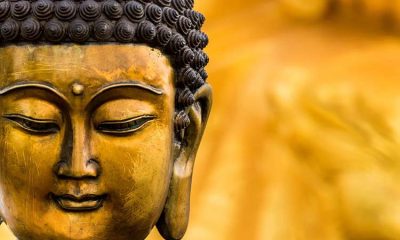Features
Travesty of Buddhism in present day Sri Lanka

 The term ‘travesty’ is defined as a false, absurd, or distorted representation of something. In this case ‘the something’ is the Teaching of the Buddha and practices and customs done and followed at present times, arising thereof. Thus the propagation of false beliefs; the emphasis given to rites and rituals which the Buddha did not approve of, and things done which are completely against what He taught.
The term ‘travesty’ is defined as a false, absurd, or distorted representation of something. In this case ‘the something’ is the Teaching of the Buddha and practices and customs done and followed at present times, arising thereof. Thus the propagation of false beliefs; the emphasis given to rites and rituals which the Buddha did not approve of, and things done which are completely against what He taught.
Crux of three previous articles
Three recent articles in the Island papers and Sunday Times dealt with relevant issues to what the title of this article implies. A very succinct article by ‘Member of the Silent Majority’ was on “The distortion of Buddhism and the rise of meaningless rituals” in the Sunday Island of November 26. S/He dealt with Katina pinkamas which were said to be more carnivals than religious festivals now. This is not only true but dangerous to the continuation of Buddhism which stresses simplicity and giving or doing good selflessly with no competitiveness or showing-off underlying intention.
Dr Upul Wijayawardhana listed in the following Sunday Island newspaper other distortions, mostly committed by monks themselves, one in particular. He titled his article Who is distorting Buddhism? and wrote “The biggest distortion happening at the moment is the rewriting of Buddha’s existence, Bhikkhus’ claim Buddha was born in SL. It is a shame that these individuals are allowed to disregard … historical evidence. Mahanayaka Theros have taken no action to prevent the spread of gross distortions.”
Tuesday December 5 The Island carried the article: “Is the Buddha’s teaching lost on us?” by Geewananda Gunawardana PhD. Talking of rituals that have crept into our practice of the Buddha Dhamma he writes: “The glaring proof that the Teaching is lost on us is the moral bankruptcy of the nation that led to the equally horrific economic bankruptcy. Moral and ethical conduct is at the root of the Noble Path; however it appears that this has been fully and completely ignored at all levels of society.”
Abuse of Buddhism –1. in places of worship
I have written many times about the gross violation of Buddhist pilgrims’ rights in the two most sacred sites in Anuradhapura.
There is absolutely no quiet and serenity in the premises of the Sacred Bo Tree. These are the two prime essentials of this most sanctified place where pilgrims can sit quietly and pay homage and gratitude to the 2500 and more years old tree which was a sapling from the tree under which Siddhartha Gautama attained Buddhahood, brought over by Theri Sangahmitta. We go to this place for quiet reflection on the Truths revealed to us and being thankful to the Buddha.
Long ago we imbibed the aura of sacredness that envelopes the place, shattered now by commercialism and false religiousness. Kapuralas, waving peacock feathers, act as intermediaries for money paid them to bless people who seek intervention in having their wants fulfilled. All against true Buddhism. Buddha showed the way to true happiness; no help from Him or from symbols of Him to alleviate trivial problems. This commonly practiced ritual demonstrates ego and soliciting material benefits either from the Tree or from devas.
Commercialism of the chanting men, cheating of gullible people and encouraging false beliefs are all allowed and maybe even connived at by the monks in charge of this most sacred site. At regular intervals poojas in the vihara below are amplified over loud speakers, blasting whatever quiet there is.
An ostentatious new vihara ge has been constructed adjacent to the Swarnamali Stupa and in the evenings, the premises are gaudy with myriad electric bulbs a-blazing. Noise of course is ever present, with a loud speaker announcing money donations.
At the Temple of the Tooth in Kandy, I fault the fact that local pilgrims are treated so badly compared to tourists by distancing the shoe keeping kiosks so far apart. No person with less mobility can worship here now. Inside, the slew of ‘pin petti’ is an eye sore. It gives the idea of money making; added to the assumption I make that tourists have to pay much to enter the Temple. The Cathedrals in London, for instance, are free for entering to all.
Even in Anuradhapura, no help is given the old, handicapped or less mobile. In the Sacred Bo Tree site cars have to be parked a good distance from the entrance. They are not allowed to come nearer the gate to drop a person off. Does security still have to be so tight? Not so. Making it difficult to worship seems to be thought to add to merit acquired. Long ago a wheelchair was available for a less able person to be wheeled from one site to the other. No longer this nod to the old.
In Kataragama is an ancient dagoba, the Kiri Vehera, dating from the reign of Kavan Tissa and Dutugemunu, I believe. But most Buddhist pilgrims head with great fervour bearing pooja vatti to the Kovil first. Veneration to the Kiri Vehera is an afterthought almost. I did not go into the kovil on family pilgrimages when I came to realize that the veneration of the Hindu Pantheon was not within Buddhism. I respected the veneration by others but did not do it myself. I was once rewarded by a monkey doing his business on me. The God teaching me a lesson?!
2. Ancient sites being sacrileged
Prez Premadasa having a stark white Buddha statue hoisted at the top of Mihintale sacred site after his Mihintale Gam Udawa; Prez Mahinda R and Gotabaya getting a stupa constructed among the ancient ones in Anuradhapura to confer merit on dead soldiers (I believe); the ostentatious Golden Temple built at the bottom of Dambulla rock temple are all sacrileges to me. Maybe these acts circumvented the rules governing heritage sites,
one example is that the rock caves at Dambulla are designated heritage sites, not the rock per se. But building new constructions on ancient sites is simply outrageous, now more than ever followed by lesser mortals sticking Buddha statues on top of hills, road junctions and in any free space, not terminated or forbidden because it is in the name/realm of Buddhism.
The latest abhorrent gimmick was robing the Aukana Buddha statue. No interference with ancient sites should be a rule strictly followed. Consider the cost of the material for that robe that covered the pristinely elegant statue of the Buddha with the folds of the robe so wonderfully carved in stone. What if a man or men climbing up to the top of the statue damaged a part of the statue which time and weather had eroded?
3. Members of the Sangha
Sri Lanka is proud to be home to excellent monks of the Theravada Sect, of local and foreign nationality, temple resident or forest dwelling, who observe the vinaya rules strictly and make clear the Teachings of the Buddha. Many are revered overseas too. For instance Ven Uda Eriyagama Dhammajiva Thera preaches alongside Bhikkhu Bodhi in New York State; local monk are invited to overseas countries to preach.
But, as being bad is easier than being good, for each praiseworthy monk there are many unworthies in yellow robes. Consider protests on streets, especially of university students. Many monks live lives of luxury and do not miss out on any pleasures. (I need not enumerate them). Heard and seen monks who support their families or ‘girl friends’ with pooja stuff given them.
A bad example of being loose mouthed, egotistic, material minded and claiming to have achieved higher mental states was written about recently in the print press. This agri-monk claims arahantship while proclaiming sacrilegious, totally unacceptable comments on the Sacred Tooth Relic and even about Bodhisatva Siddhartha Gautama while on his way to enlightenment.
Then this monk goes before the Kandy Mahanayake Theras and probably a Sabha and seeks forgiveness and is given it, for the second or third time of gross transgression. Consider in contrast what happened to Preacher Jerome Fernando and that hapless singer whose injurious remarks about the Buddha could easily have been treated with a reprimand.
Another travesty committed by over jealous persons has resulted in the demise of the white cloth covered, straight backed chair on which bhikkhus sat to deliver sermons. Pragna TV Channel shows all sorts of gruesomely designed and elaborately crafted thrones for preaching monks. So against simplicity implicit in Buddhism.
Responsible for maintaining the sanctity of Buddhism
There exists the Ministry of Buddha Sasana, Religious and Cultural Affairs which is a Cabinet Ministry responsible for the country’s de facto state religion -Theravada Buddhism. Its duties given short below, cover much ground through overseeing: general welfare of Buddhist clergy; Buddhist education; development of temples as community and spiritual centres; maintenance of selected places of Buddhist worship as tourist sites; propagation of Buddhist philosophy; maintaining the nature of the Buddhist state.
PHEW!! Do they fulfill all or many or even a few of the above duties? If so we need not write these articles.
The Most Ven Malwatte and Asgiriya Mahanayake Theros have the responsibility of keeping the Bhikkhu Sangha pure, chaste and with no blemishes accruing to any Bhikkhus. I leave it at that.
The conclusion is that segments of the public who are followers of true, unadulterated Theravada Buddhism are the ones who see obvious faults in Buddhist matters as they are now. Additionally, it looks as if they are the ones who try correcting matters. The only way open to them is to write to the media drawing attention to misdeeds and shortcomings, and suggest, nay plead, for correction, protection and elimination of abuses to the Teacher, His Teaching and its interpretation; and to Buddhist sites.
Features
The heart-friendly health minister

by Dr Gotabhya Ranasinghe
Senior Consultant Cardiologist
National Hospital Sri Lanka
When we sought a meeting with Hon Dr. Ramesh Pathirana, Minister of Health, he graciously cleared his busy schedule to accommodate us. Renowned for his attentive listening and deep understanding, Minister Pathirana is dedicated to advancing the health sector. His openness and transparency exemplify the qualities of an exemplary politician and minister.
Dr. Palitha Mahipala, the current Health Secretary, demonstrates both commendable enthusiasm and unwavering support. This combination of attributes makes him a highly compatible colleague for the esteemed Minister of Health.
Our discussion centered on a project that has been in the works for the past 30 years, one that no other minister had managed to advance.
Minister Pathirana, however, recognized the project’s significance and its potential to revolutionize care for heart patients.
The project involves the construction of a state-of-the-art facility at the premises of the National Hospital Colombo. The project’s location within the premises of the National Hospital underscores its importance and relevance to the healthcare infrastructure of the nation.
This facility will include a cardiology building and a tertiary care center, equipped with the latest technology to handle and treat all types of heart-related conditions and surgeries.
Securing funding was a major milestone for this initiative. Minister Pathirana successfully obtained approval for a $40 billion loan from the Asian Development Bank. With the funding in place, the foundation stone is scheduled to be laid in September this year, and construction will begin in January 2025.
This project guarantees a consistent and uninterrupted supply of stents and related medications for heart patients. As a result, patients will have timely access to essential medical supplies during their treatment and recovery. By securing these critical resources, the project aims to enhance patient outcomes, minimize treatment delays, and maintain the highest standards of cardiac care.
Upon its fruition, this monumental building will serve as a beacon of hope and healing, symbolizing the unwavering dedication to improving patient outcomes and fostering a healthier society.We anticipate a future marked by significant progress and positive outcomes in Sri Lanka’s cardiovascular treatment landscape within the foreseeable timeframe.
Features
A LOVING TRIBUTE TO JESUIT FR. ALOYSIUS PIERIS ON HIS 90th BIRTHDAY

by Fr. Emmanuel Fernando, OMI
Jesuit Fr. Aloysius Pieris (affectionately called Fr. Aloy) celebrated his 90th birthday on April 9, 2024 and I, as the editor of our Oblate Journal, THE MISSIONARY OBLATE had gone to press by that time. Immediately I decided to publish an article, appreciating the untiring selfless services he continues to offer for inter-Faith dialogue, the renewal of the Catholic Church, his concern for the poor and the suffering Sri Lankan masses and to me, the present writer.
It was in 1988, when I was appointed Director of the Oblate Scholastics at Ampitiya by the then Oblate Provincial Fr. Anselm Silva, that I came to know Fr. Aloy more closely. Knowing well his expertise in matters spiritual, theological, Indological and pastoral, and with the collaborative spirit of my companion-formators, our Oblate Scholastics were sent to Tulana, the Research and Encounter Centre, Kelaniya, of which he is the Founder-Director, for ‘exposure-programmes’ on matters spiritual, biblical, theological and pastoral. Some of these dimensions according to my view and that of my companion-formators, were not available at the National Seminary, Ampitiya.
Ever since that time, our Oblate formators/ accompaniers at the Oblate Scholasticate, Ampitiya , have continued to send our Oblate Scholastics to Tulana Centre for deepening their insights and convictions regarding matters needed to serve the people in today’s context. Fr. Aloy also had tried very enthusiastically with the Oblate team headed by Frs. Oswald Firth and Clement Waidyasekara to begin a Theologate, directed by the Religious Congregations in Sri Lanka, for the contextual formation/ accompaniment of their members. It should very well be a desired goal of the Leaders / Provincials of the Religious Congregations.
Besides being a formator/accompanier at the Oblate Scholasticate, I was entrusted also with the task of editing and publishing our Oblate journal, ‘The Missionary Oblate’. To maintain the quality of the journal I continue to depend on Fr. Aloy for his thought-provoking and stimulating articles on Biblical Spirituality, Biblical Theology and Ecclesiology. I am very grateful to him for his generous assistance. Of late, his writings on renewal of the Church, initiated by Pope St. John XX111 and continued by Pope Francis through the Synodal path, published in our Oblate journal, enable our readers to focus their attention also on the needed renewal in the Catholic Church in Sri Lanka. Fr. Aloy appreciated very much the Synodal path adopted by the Jesuit Pope Francis for the renewal of the Church, rooted very much on prayerful discernment. In my Religious and presbyteral life, Fr.Aloy continues to be my spiritual animator / guide and ongoing formator / acccompanier.
Fr. Aloysius Pieris, BA Hons (Lond), LPh (SHC, India), STL (PFT, Naples), PhD (SLU/VC), ThD (Tilburg), D.Ltt (KU), has been one of the eminent Asian theologians well recognized internationally and one who has lectured and held visiting chairs in many universities both in the West and in the East. Many members of Religious Congregations from Asian countries have benefited from his lectures and guidance in the East Asian Pastoral Institute (EAPI) in Manila, Philippines. He had been a Theologian consulted by the Federation of Asian Bishops’ Conferences for many years. During his professorship at the Gregorian University in Rome, he was called to be a member of a special group of advisers on other religions consulted by Pope Paul VI.
Fr. Aloy is the author of more than 30 books and well over 500 Research Papers. Some of his books and articles have been translated and published in several countries. Among those books, one can find the following: 1) The Genesis of an Asian Theology of Liberation (An Autobiographical Excursus on the Art of Theologising in Asia, 2) An Asian Theology of Liberation, 3) Providential Timeliness of Vatican 11 (a long-overdue halt to a scandalous millennium, 4) Give Vatican 11 a chance, 5) Leadership in the Church, 6) Relishing our faith in working for justice (Themes for study and discussion), 7) A Message meant mainly, not exclusively for Jesuits (Background information necessary for helping Francis renew the Church), 8) Lent in Lanka (Reflections and Resolutions, 9) Love meets wisdom (A Christian Experience of Buddhism, 10) Fire and Water 11) God’s Reign for God’s poor, 12) Our Unhiddden Agenda (How we Jesuits work, pray and form our men). He is also the Editor of two journals, Vagdevi, Journal of Religious Reflection and Dialogue, New Series.
Fr. Aloy has a BA in Pali and Sanskrit from the University of London and a Ph.D in Buddhist Philosophy from the University of Sri Lankan, Vidyodaya Campus. On Nov. 23, 2019, he was awarded the prestigious honorary Doctorate of Literature (D.Litt) by the Chancellor of the University of Kelaniya, the Most Venerable Welamitiyawe Dharmakirthi Sri Kusala Dhamma Thera.
Fr. Aloy continues to be a promoter of Gospel values and virtues. Justice as a constitutive dimension of love and social concern for the downtrodden masses are very much noted in his life and work. He had very much appreciated the commitment of the late Fr. Joseph (Joe) Fernando, the National Director of the Social and Economic Centre (SEDEC) for the poor.
In Sri Lanka, a few religious Congregations – the Good Shepherd Sisters, the Christian Brothers, the Marist Brothers and the Oblates – have invited him to animate their members especially during their Provincial Congresses, Chapters and International Conferences. The mainline Christian Churches also have sought his advice and followed his seminars. I, for one, regret very much, that the Sri Lankan authorities of the Catholic Church –today’s Hierarchy—- have not sought Fr.
Aloy’s expertise for the renewal of the Catholic Church in Sri Lanka and thus have not benefited from the immense store of wisdom and insight that he can offer to our local Church while the Sri Lankan bishops who governed the Catholic church in the immediate aftermath of the Second Vatican Council (Edmund Fernando OMI, Anthony de Saram, Leo Nanayakkara OSB, Frank Marcus Fernando, Paul Perera,) visited him and consulted him on many matters. Among the Tamil Bishops, Bishop Rayappu Joseph was keeping close contact with him and Bishop J. Deogupillai hosted him and his team visiting him after the horrible Black July massacre of Tamils.
Features
A fairy tale, success or debacle

Sri Lanka-Singapore Free Trade Agreement
By Gomi Senadhira
senadhiragomi@gmail.com
“You might tell fairy tales, but the progress of a country cannot be achieved through such narratives. A country cannot be developed by making false promises. The country moved backward because of the electoral promises made by political parties throughout time. We have witnessed that the ultimate result of this is the country becoming bankrupt. Unfortunately, many segments of the population have not come to realize this yet.” – President Ranil Wickremesinghe, 2024 Budget speech
Any Sri Lankan would agree with the above words of President Wickremesinghe on the false promises our politicians and officials make and the fairy tales they narrate which bankrupted this country. So, to understand this, let’s look at one such fairy tale with lots of false promises; Ranil Wickremesinghe’s greatest achievement in the area of international trade and investment promotion during the Yahapalana period, Sri Lanka-Singapore Free Trade Agreement (SLSFTA).
It is appropriate and timely to do it now as Finance Minister Wickremesinghe has just presented to parliament a bill on the National Policy on Economic Transformation which includes the establishment of an Office for International Trade and the Sri Lanka Institute of Economics and International Trade.
Was SLSFTA a “Cleverly negotiated Free Trade Agreement” as stated by the (former) Minister of Development Strategies and International Trade Malik Samarawickrama during the Parliamentary Debate on the SLSFTA in July 2018, or a colossal blunder covered up with lies, false promises, and fairy tales? After SLSFTA was signed there were a number of fairy tales published on this agreement by the Ministry of Development Strategies and International, Institute of Policy Studies, and others.
However, for this article, I would like to limit my comments to the speech by Minister Samarawickrama during the Parliamentary Debate, and the two most important areas in the agreement which were covered up with lies, fairy tales, and false promises, namely: revenue loss for Sri Lanka and Investment from Singapore. On the other important area, “Waste products dumping” I do not want to comment here as I have written extensively on the issue.
1. The revenue loss
During the Parliamentary Debate in July 2018, Minister Samarawickrama stated “…. let me reiterate that this FTA with Singapore has been very cleverly negotiated by us…. The liberalisation programme under this FTA has been carefully designed to have the least impact on domestic industry and revenue collection. We have included all revenue sensitive items in the negative list of items which will not be subject to removal of tariff. Therefore, 97.8% revenue from Customs duty is protected. Our tariff liberalisation will take place over a period of 12-15 years! In fact, the revenue earned through tariffs on goods imported from Singapore last year was Rs. 35 billion.
The revenue loss for over the next 15 years due to the FTA is only Rs. 733 million– which when annualised, on average, is just Rs. 51 million. That is just 0.14% per year! So anyone who claims the Singapore FTA causes revenue loss to the Government cannot do basic arithmetic! Mr. Speaker, in conclusion, I call on my fellow members of this House – don’t mislead the public with baseless criticism that is not grounded in facts. Don’t look at petty politics and use these issues for your own political survival.”
I was surprised to read the minister’s speech because an article published in January 2018 in “The Straits Times“, based on information released by the Singaporean Negotiators stated, “…. With the FTA, tariff savings for Singapore exports are estimated to hit $10 million annually“.
As the annual tariff savings (that is the revenue loss for Sri Lanka) calculated by the Singaporean Negotiators, Singaporean $ 10 million (Sri Lankan rupees 1,200 million in 2018) was way above the rupees’ 733 million revenue loss for 15 years estimated by the Sri Lankan negotiators, it was clear to any observer that one of the parties to the agreement had not done the basic arithmetic!
Six years later, according to a report published by “The Morning” newspaper, speaking at the Committee on Public Finance (COPF) on 7th May 2024, Mr Samarawickrama’s chief trade negotiator K.J. Weerasinghehad had admitted “…. that forecasted revenue loss for the Government of Sri Lanka through the Singapore FTA is Rs. 450 million in 2023 and Rs. 1.3 billion in 2024.”
If these numbers are correct, as tariff liberalisation under the SLSFTA has just started, we will pass Rs 2 billion very soon. Then, the question is how Sri Lanka’s trade negotiators made such a colossal blunder. Didn’t they do their basic arithmetic? If they didn’t know how to do basic arithmetic they should have at least done their basic readings. For example, the headline of the article published in The Straits Times in January 2018 was “Singapore, Sri Lanka sign FTA, annual savings of $10m expected”.
Anyway, as Sri Lanka’s chief negotiator reiterated at the COPF meeting that “…. since 99% of the tariffs in Singapore have zero rates of duty, Sri Lanka has agreed on 80% tariff liberalisation over a period of 15 years while expecting Singapore investments to address the imbalance in trade,” let’s turn towards investment.
Investment from Singapore
In July 2018, speaking during the Parliamentary Debate on the FTA this is what Minister Malik Samarawickrama stated on investment from Singapore, “Already, thanks to this FTA, in just the past two-and-a-half months since the agreement came into effect we have received a proposal from Singapore for investment amounting to $ 14.8 billion in an oil refinery for export of petroleum products. In addition, we have proposals for a steel manufacturing plant for exports ($ 1 billion investment), flour milling plant ($ 50 million), sugar refinery ($ 200 million). This adds up to more than $ 16.05 billion in the pipeline on these projects alone.
And all of these projects will create thousands of more jobs for our people. In principle approval has already been granted by the BOI and the investors are awaiting the release of land the environmental approvals to commence the project.
I request the Opposition and those with vested interests to change their narrow-minded thinking and join us to develop our country. We must always look at what is best for the whole community, not just the few who may oppose. We owe it to our people to courageously take decisions that will change their lives for the better.”
According to the media report I quoted earlier, speaking at the Committee on Public Finance (COPF) Chief Negotiator Weerasinghe has admitted that Sri Lanka was not happy with overall Singapore investments that have come in the past few years in return for the trade liberalisation under the Singapore-Sri Lanka Free Trade Agreement. He has added that between 2021 and 2023 the total investment from Singapore had been around $162 million!
What happened to those projects worth $16 billion negotiated, thanks to the SLSFTA, in just the two-and-a-half months after the agreement came into effect and approved by the BOI? I do not know about the steel manufacturing plant for exports ($ 1 billion investment), flour milling plant ($ 50 million) and sugar refinery ($ 200 million).
However, story of the multibillion-dollar investment in the Petroleum Refinery unfolded in a manner that would qualify it as the best fairy tale with false promises presented by our politicians and the officials, prior to 2019 elections.
Though many Sri Lankans got to know, through the media which repeatedly highlighted a plethora of issues surrounding the project and the questionable credentials of the Singaporean investor, the construction work on the Mirrijiwela Oil Refinery along with the cement factory began on the24th of March 2019 with a bang and Minister Ranil Wickremesinghe and his ministers along with the foreign and local dignitaries laid the foundation stones.
That was few months before the 2019 Presidential elections. Inaugurating the construction work Prime Minister Ranil Wickremesinghe said the projects will create thousands of job opportunities in the area and surrounding districts.
The oil refinery, which was to be built over 200 acres of land, with the capacity to refine 200,000 barrels of crude oil per day, was to generate US$7 billion of exports and create 1,500 direct and 3,000 indirect jobs. The construction of the refinery was to be completed in 44 months. Four years later, in August 2023 the Cabinet of Ministers approved the proposal presented by President Ranil Wickremesinghe to cancel the agreement with the investors of the refinery as the project has not been implemented! Can they explain to the country how much money was wasted to produce that fairy tale?
It is obvious that the President, ministers, and officials had made huge blunders and had deliberately misled the public and the parliament on the revenue loss and potential investment from SLSFTA with fairy tales and false promises.
As the president himself said, a country cannot be developed by making false promises or with fairy tales and these false promises and fairy tales had bankrupted the country. “Unfortunately, many segments of the population have not come to realize this yet”.
(The writer, a specialist and an activist on trade and development issues . )
























